Disclosure: Meeple Mountain received a free copy of this product in exchange for an honest, unbiased review. This review is not intended to be an endorsement.
There are boundless joys I get from working with Meeple Mountain, and one of those is the opportunity to see a game before it makes it to store shelves. Hedge Mage is a game about making hedge mazes to prevent mages from stealing garden gnomes… while you are in another hedge maze stealing garden gnomes. To say I was intrigued would be an understatement.
I have played a few games of this now (several by myself as I simulated other players in an attempt to get my head around what is going on in this game), a few games with my wife (two-players) and my game group (4 players) and, if I were to bottom line this, I would say: this game needs more time in development.
Setup
When Hedge Mage is set up and ready to play, this image shows what one player might see:
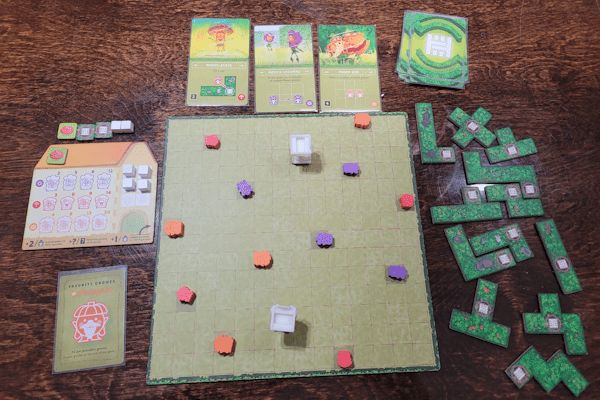
So let’s break this down:
- Three gnome ceremony cards are selected at random. This will be one card for each type of gnome (pumpkin, flower, and mushroom).
- On the players’ garden boards, there are spaces that are of a darker color of green. Six of those spaces are numbered. The pumpkin and mushroom gnome ceremony cards have a number in the lower left. This is the location of the tunnels in each of the boards.
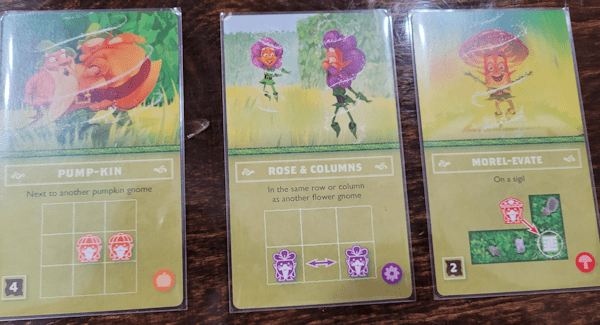

- Each player will then place their plastic mage pieces on the tunnel spaces of the player to their right.
- Each player then takes twelve gnomes (four each of the three types) and randomizes them so that they can place them onto their board in the remaining darker colored squares. Each gnome should be placed with the printed side face down (i.e., the gnomes are asleep). When they get woken (see below), they are flipped so that the gnomes are printed side face up.
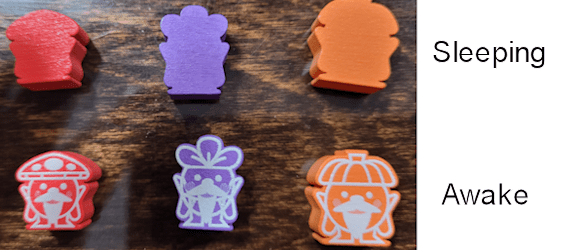
- Each player starts with a springshroom mushroom token and four movement tokens. These are placed on their gnome sweet gnome board. The remaining two springshroom mushroom tokens, the two flower power tokens, and two movement tokens are placed nearby.

- Each player takes their polyomino hedge tokens and places them next to their board. The hedge cards are shuffled, and two are removed. The remaining 10 cards are the deck. Each hedge card has an image that corresponds to one of the polyominoes. In this way, none of the players know which two tokens will not be used in the game.
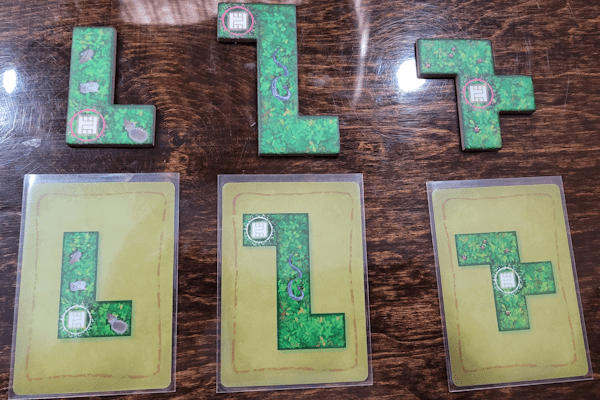
- Finally, the favorite gnome cards are shuffled and one is dealt to each player. Players should keep this a secret! This is not public knowledge.
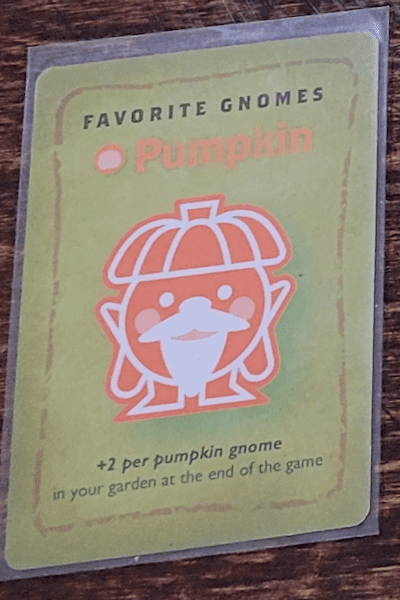
Setup is complete and the game can begin.
Playing the Game
There are a maximum of 10 turns in the game. The game will end following any turn where a player has rescued all of their gnomes, or when the final hedge card has been revealed. Each turn consists of two phases: the Maze Building phase and the Maze Running phase.
Maze Building
In the Maze Building phase, the top card of the hedge deck is revealed. The hedge tile pictured is the tile that will be used by all players. Players take this tile and place it on their board. There are two things that need to be kept in mind when placing a new hedge tile:
- There are some restrictions: tiles cannot be placed in such a way that any part of the tile would be off the board, on top of some other element on the board, or so as to cut some part of the board off from some other part of the board. Also you cannot place pieces so as to create large clumps of hedges (a block of hedge that is 2×2 or larger).
- You generate movement points for the second phase of the game by having the sigils of previously placed hedge tokens in the same row and/or column of the hedge token you just placed. The sigils themselves do not need to line up; the previously placed hedge tile sigils need to be in a row or column of the tile you just placed in order to count.
That second point is a bit of a bear. More on that later.
Once you know how many movement points you have, you can move onto the next phase.
Maze Running
Armed with the knowledge of how many movement points you start with, each player moves from their garden board to the garden board of the player on their right. That player’s board is where the Maze Running phase will take place.
Players may move each of their mages a number of spaces equal to the number of movement points they have. If they need more, they can spend movement tokens from their gnome sweet gnome board. However many movement points they have is how many spaces each of their mages can move. Each mage can perform some movement, stop, and resume their movement later, just so long as they do not exceed their allotted number of movement points.
If a mage is adjacent to a gnome, they can pick it up for one movement point. If a mage is in the same space as a gnome, it takes zero movement points to pick it up. A mage may put a gnome down into an adjacent space for one movement point. A mage may put a gnome down into their space for zero movement points.
In addition to their mages, players may move one awakened gnome of each color each turn. This means that if they have an awakened pumpkin gnome, two awakened flower gnomes, and four awakened mushroom gnomes, the player may move one pumpkin, one flower, and one mushroom gnome a number of spaces equal to the player’s movement points. The gnome that moves can be a gnome that was awakened this turn.
A mage can put a gnome down into an adjacent hedge space. The gnome is considered on top of the hedge until they make a move that would put them back at ground level. Normally, a mage cannot move on top of a hedge (however, there are Springshroom Mushrooms).
The idea of the game is to get awakened gnomes to one of the tunnel spaces. If an awakened gnome enters a tunnel space, it is removed from the garden board and placed on the rescuing player’s gnome sweet gnome board in the left-most space of the appropriate row.
The symbol that is covered up by the rescued gnome indicates the bonus that is received. This can be:
- Movement tokens
- Flower Power tokens
- Springshroom Mushrooms
Bonuses, when gained, are placed on the player’s gnome sweet gnome board to indicate they are ready to be used.
A player cannot have more than six movement tokens at any given time (there are six spaces on their board). Movement tokens can be spent at any time during the Maze Running phase to increase the number of movement points available to the player for that turn by one for each token spent.
Flower Power tokens can be spent at any time during the Maze Building phase. The token is placed on the hedge piece that is being placed that turn, and counts as a sigil for that turn and all future turns.
Springshroom Mushroom tokens can be spent at any time during the Maze Running step. Any mage or gnome which finds itself in the same space as one of these pieces is immediately moved to an adjacent space at no movement cost. This can include onto the top of an adjacent hedge space (this is how a mage can end up on a hedge).
The game is won or lost on your ability to awaken gnomes so that they do not need to be carried everywhere. In fact, a sleeping gnome that is placed on a tunnel space is not rescued, and actually blocks the tunnel from being used. So how do we wake gnomes?
Waking Gnomes
Each of the three types of gnomes has a ceremony that will wake them. These are selected randomly at the start of the game from the three possible ceremonies for each type of gnome. In the example cards used above, we have:
- Pumpkin gnomes which are in adjacent spaces with each other wake up.
- Flower gnomes in the same row or column with each other wake up.
- Mushroom gnomes that are on a sigil wake up.
As indicated, there are three potential ceremonies for each type of gnome. Sometimes they are awoken in pairs, sometimes singly. In general, the easiest to wake up are flower gnomes, followed by mushroom gnomes, and then pumpkin gnomes.
The end of the game comes when a player has rescued all of the gnomes on their rival’s board, or after 10 turns, whichever comes first.
Scoring
Players score points based on the number of gnomes of each type they have rescued. For example:
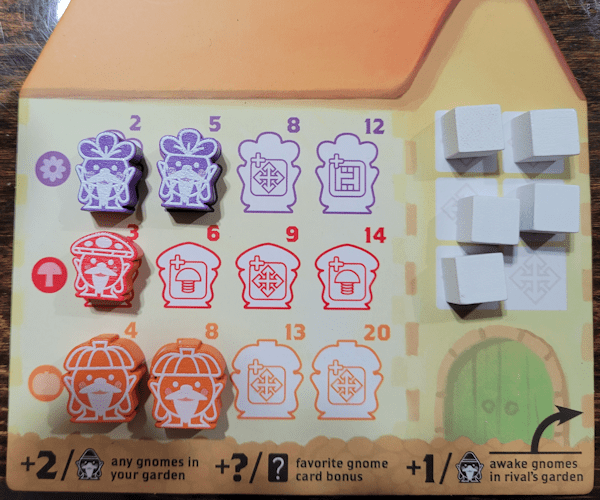
This player would receive 5 points from flower gnomes, 3 points from mushroom gnomes, and 8 points from pumpkin gnomes.
Additionally, the bottom of the gnome sweet gnome board shows the other three ways of getting points:
- Any gnomes that remain in your garden (where the player to your left was attempting to steal them and failed), you get +2 points.
- You have a favorite gnome card. Each of the gnomes that remain in your garden of that type, are worth bonus points as indicated on your favorite gnome card.
- Each gnome you managed to awaken but not get out of your rival’s garden is worth+1 point.
The player with the highest score wins.
Thoughts, Hopes, and Dreams
Hedge Mage is an interesting and thought provoking game. My wife, my game group, and I all agree that there are some great ideas at work here. They almost, but not quite, come together to form a fun and enjoyable gaming experience.
In order to win this game, you need to maximize your movement. You are playing offense all the time; defense is, at most, an afterthought. On your turn, you are spending most of your time in your rival’s hedge maze waking and rescuing the gnomes. Your only defense is in the way you place your hedge pieces to slow down an opponent. You need a lot of movement, and your options for blocking are relatively limited. So, in the end, if you have a choice where one placement of your hedge piece that maximizes movement, while another placement maximizes defense… movement will always win. It has to.
Add to this the fact that you spend 10% of your time on your garden board, and 90% on an opponent’s garden board. In a two player game, this is not a major obstacle, as the boards can be placed next to each other. In this way, you place your hedge pieces on the board to your left, and move pieces on the board to your right. Once you get a group of three or four together to play this, it seems to only work if people do their Maze Building phase in one chair, then everyone moves over to their rival’s chair and does the Maze Running, before returning to their own chair for the next round.
There are other issues:
- In addition to having limited defense, you have no way to focus protection on your favored gnomes. This means that the bonus points you get here have less to do with your success and more to do with your left-side opponent’s failure.
- The garden boards are all the same and printed on both sides. Seems like a different layout of the numbers and/or the dark spaces on the back side would be good. Let players pick the ‘A’ or ‘B’ side, or perhaps have each player select whichever side they want to use.
- The defensive nature of the hedge tiles is further limited by the fact that a block of hedge that is 2×2 or larger is prohibited. This rule means that very often the best defensive placement of the hedge piece is not legal.
Thematically speaking, there are a lot of missed opportunities as well. For example, the bonuses for rescuing gnomes are all movement: bonus movement tokens, bonus movement from sigils, and bonus movement from the placement of Springshroom Mushrooms.
The game is called Hedge Mage! I would say that the word ‘mage’ in the title has no bearing on the mechanics of the game. If, however, you allowed for some magic… Assume for example, there existed a spell deck that you could draw from when you got a spell reward for some gnome spaces. Even if the spells you included were limited to effects that impacted only your own garden board and the casting of spells were limited to the Maze Building phase, these effects could make defense viable. Spells could, for example, put awakened gnomes back to sleep; move sleeping gnomes; move/rotate/flip previously placed hedge tiles; allow a player to move their opponent’s mages on their board; and so on.
As is, this is a decent game that could – and should – have been so much more.











Add Comment